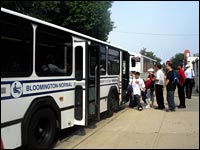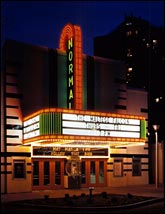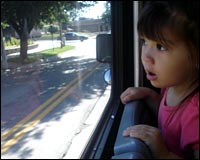Not 20 minutes after the Amtrak clerk said our train would be at least an hour late — “probably much more” — I almost caved. “We could rent a car and drive home,” I thought, and maybe even muttered. “Nobody has to know.”
I had just hit my breaking point.

Carolyn rides the bus.
Photos: Christine Gardner
My husband, Steve, and I were pushing our two daughters along a searing sidewalk built precariously close to a major road, beer-bottle shards crunching underfoot. We were in Illinois’ state capital of Springfield, just 70 miles from our Normal home, and I was on my 20th car-free day.
In the pit of my stomach I could feel the onset of failure.
But we pushed on. We pushed past the track-marked girl sitting two booths from us at McDonald’s. We pushed to a shaded grassy hill in view of the capitol building. Eventually we pushed into a hotel for the night, where we imbibed on the floor of the bathroom, our two-year-old finally asleep in a bed and her baby sister snoozing in a complimentary playpen.
This isn’t starting well, you might think. A suburban housewife gives up driving for one month and comes away reporting that it can’t be done. How helpful is that?
Yes, the laundry list is long. Food costs are exorbitant, a problem for households with only one steady paycheck. Public transportation often is difficult and confusing. Vacationing is expensive and, as you might have gathered, hellish.
But we did it. Coated in grime, feet aching and exhausted, we made it home without an automobile. And suddenly, this experience seemed a little more like adventure and a little less like failure.
Getting started: “Green A” bus to downtown Bloomington, 8:10 a.m., July 1
My first bus trip rocked.
My older daughter and I headed to the farmers’ market for as many vegetables as we could cram in our backpacks. After shopping, I set Carolyn free on the lawn of the city square. Within minutes, she met Dana, also 2, who seemed just as interested as my daughter in climbing a sign marking the downtown landmark.
Dana turned out to belong to Sara Freeman, an assistant professor of theater at Illinois Wesleyan University, a former resident of Madison and Chicago, and part of a one-car household. This is too easy, I thought. My first day and I’m already meeting kindred spirits, automotively speaking.
The thing is, Sara would tell me later, owning just one car isn’t that big a deal. She sometimes walks. Her husband rides his bike. They carpool or trade off. They have to be conscious of who has the car when, but it hasn’t really been a problem.
Like others who live in the twin cities of Bloomington-Normal, Sara sees the divide. There are people who live in the older neighborhoods, closer to the downtowns, and others living in newer, often swankier homes east of Veteran’s Parkway, this city’s commercial artery to Wal-Mart and all its big-box buddies. One set thinks, “Ugh, I have to go out to Veteran’s.” The other thinks, “Thank god I don’t have to go downtown.”
At the university, there’s talk about sustainability, how to reach students and the general public. Sara, who is pregnant with her second child and thinking maybe her family needs another car, said she wishes this area had enough people to make a car-share program work. That way, she said, she wouldn’t have to go car shopping — and I wouldn’t get stuck during a day trip to Springfield.
En route: “Pink D” bus to Meijer Super Store, 8:58 a.m., July 10
Ten days into this experiment, I knew one thing for sure — the stroller is the most hated object in all of bus world. This, for me, was made much more frustrating by my fumbling attempts to steer my extra-long double stroller. To make matters worse, I sometimes require the dreaded wheelchair lift. A friend of mine with two young children said I shouldn’t let it bother me: “It’s the same as a wheelchair,” she said. I suppose that’s true. “Having kids is like being handicapped,” she added.

Just another Normal day.
Hmm.
But a bus ride with small children is an effort in feeling bad, and a tiny bit hindered. One morning, as a particularly crowded bus arrived, Steve and I had both girls and the stroller and asked to use the lift. Our driver obliged. A passenger on his cell phone warned someone he’d be late. A family and their kids are getting on, he said.
As I got off the bus, the driver said into her walkie-talkie, “Her husband is here, but she wants to use the lift.” That’s what I’d thought I was supposed to do. Now, because of me, all these people were late for work.
It all begged the question, “Who is public transportation for?” A 2003 study of the local transit system showed that most people who take the bus don’t do so by choice. Randomly surveyed people didn’t care much about public transit, other than not really wanting to fund improvements.
Melanie Overend of Bloomington-Normal Public Transit says the system’s No. 1 objective is to provide a ride to those who need it, although efforts are made to convince others to ride. But with light traffic, free parking, and a phobia I like to call “I Might Come in Contact with Poor People,” it’s a tough sell.
Back on the Pink D, in an effort to speed things along, I tried to be helpful and lift my stroller with one arm and my chunky baby Penelope with the other. A stranger, one of many to lend a hand during this experiment, grabbed the 25-pound device from me.
We were going to Meijer Superstore, a Michigan-based Wal-Mart predecessor, for what would be the last major shopping trip of the month (mostly because it became a huge pain). Later, I would settle on paying $4.49 for a box of butter at a downtown drugstore, $1.25 for a cup of sour cream at the gas station, and $8.99 for a pound of coffee at the vegetarian deli — items that total $6.70 at Wal-Mart prices.
It’s not unusual, or that surprising, to see people on the bus hauling plastic bags from America’s favorite superstore. When I look at the other passengers, I mostly see people with no alternative to the bus. I try not to inconvenience them, or knock them with my stroller.
How I learned to stop worrying and love the bus: Black Mazda to Normal, Ill., February 2006
I had high hopes for Normal.
Let me begin by saying I have never claimed to be an environmentalist. My father, a Nebraska-born farm boy, saves rainwater for his vegetable garden and has been known to reuse coffee filters, but these are not altruistic actions. As for me, I grew up inside Detroit’s city limits, with strong memories of trash-littered streets and exhaust-blackened snow. The poor — and also my father — collected pop and beer cans for their 10 cent deposit, but again, it wasn’t really about the environment.
Oddly enough, I also knew about exploring the great outdoors from spending time on my grandparents’ small farm. What I lacked was an understanding of life in the middle.
How did I come to live in a suburban setting? Economics. The housing market. The job market. Children. My husband’s own suburban childhood. Dumb luck.
I left the workplace after the birth of my second child and decided to create my own version of suburbia — a safe, comfortable place within walking distance of a downtown, or a store, or a bakery. Our post-World War II ranch, with a measly 1,600 square feet but two full baths, has large trees in the backyard. It’s a mile from downtown Normal and within walking distance of six parks. I’m pretty friendly with my immediate neighbors, some of whom are original owners in this neighborhood.
Mary and Byron Benscoter bought their house in 1955 and raised three children there. They told me that in the beginning, this street was congested with children and by mid-morning, housewives would generally be out mingling. Just a few blocks away, there was a corner store, a gas station, and a restaurant. Families didn’t have a lot of money, Mary said, so there wasn’t much traveling, and the moms weren’t running kids to activities all over town.
The neighborhood, which was built on an old vegetable farm, is different today. There are some older families and some young, childless couples. There are very few children. It seems most families prefer newer homes, and our realtor, who had raised her own four children in this very neighborhood, had warned us: they prefer to live east of Veteran’s Parkway.
There’s that street again.
I can sit at the playground closest to my house, across a parking lot from a swimming club, and watch minivans come and go for hours. To my knowledge, I’m the only mom who walks there.
I instinctively believe that people are driving too much, too far, in too large of vehicles. The numbers tell me I’m right. The Environmental Protection Agency released a “Holy Crap We Drive A Lot” report in April, stating that the United States is responsible for a quarter of the world’s greenhouse-gas emissions. Using data from 1990 to 2004, it reports that the popularity of SUVs and minivans is increasing. The number of miles we drive is increasing. The number of cars is increasing. The number of households with more than four vehicles now exceeds the number with none.
I live in a neighborhood that once enjoyed a childhood of its own, but now has settled into a sort of middle age. With my lime-green bus pass, July became the month when I reverted to a forgotten time, agreeing with a frequent request from my two-year-old: “Bus? Sure. Let’s take the bus.”
The slow and the curious: Walking near downtown Normal, 7:30 a.m., July 9
For all the places the bus took me, and as much as I relied on it, I have one major complaint. It doesn’t run on Sunday, known in some circles as the Lord’s Day.
Walking was my only other option — not usually an awful one, until you consider the oppressive heat of a Midwestern July. So why not try church?
I arrived there with Penelope and could feel the eyes of churchgoers watching me park the stroller under a tree, curious about this unfamiliar scene. I wish the world didn’t see a pedestrian and her sweaty baby as objects of pity.
The gospel that day was a story of Jesus losing his ability to perform miracles because the townspeople lacked faith. After a woman of faith touched him (I never realized how Freudian church could be), he recovered his healing hands. The priest also made some reference to the broken air conditioner.
I left early, when a hungry Penelope started to wail, and made my way downtown, where an art festival was waking up for a final day. The day promised to be especially sticky, so at 9 a.m., I started moseying homeward on the 24-mile Constitution Trail, already busy with runners and cyclists. I felt fortunate to have gone out so early.
It had been about an hour since I left the church, and as I passed by it again I stopped to feed Penelope at a nearby playground. From the park bench, I watched dozens of cars trickle out of the church’s parking lot. Then I saw one older couple leaving on foot. I thought, “At least somebody else gets it.”
Getting home: “Red B” bus leaving Target, 10:35 a.m., July 24
There is nothing more unpredictable than the temperament of a two-year-old. One day, she’s sickly sweet. The next, she’s throwing herself on the floor of Target, grinning ever so slightly.
I did most of my July discount shopping at Target. The major grocery stores, including Wal-Mart, were difficult to reach despite being located less than a mile from one another. Major shopping trips became a nightmare. And again, that’s not taking my two-year-old X factor into consideration.

But Mom, I miss the car!
On that 24th day without a car, after the novelty of the bus had worn off, Carolyn went into toddler overdrive. She pulled the hair, twice, of a woman seated in front of us. She ran away from me inside the store. Then, as I tried to discipline her, we missed our bus back to Normal. When we finally returned to Normal, we missed our bus home.
Carolyn had cried on and off all morning. This time, my own tears began to well. In desperation, I called Steve to come get Carolyn, and he did. I walked home, temperatures now into the 90s. As that damn Orange H passed me, I realized a one-hour trip had taken three hours.
That’s the thing about the bus. It’s usually on time. It always runs the same route. So why is it that every time we take it, our experience is different? If I drove 20 times to the store with as many different routes, every trip would be nearly identical.
Returning to Normal
That trip to Springfield began a slow decline in any interest I had in leaving the house. Before the trip, I had taken the bus 27 times. I took it only 13 after, and never again with the stroller. We started spending more time at the local park and in our backyard kiddie pool.
Not driving didn’t seem that inconvenient at first, because I prefer walking anyway, if I’m not going too far. It’s not about the environment. I just like the idea of living simply, especially since having my girls.
I can hear some of you: “Shut up already about your kids.” I say let’s talk a little more about kids. Kids and safety, two topics never in short supply at the playground.
Month after month, Parents magazine implores moms to see the dangers. Germs. Pacifiers. Bottle feeding. Cribs. Carseat installation. Sudden Infant Death Syndrome. And that’s just a sampling of the August issue.

The movie’s over, but the
story’s just beginning.
Photo: Dawn Riordan
But nothing is more unsafe than creating an inhospitable world for our children. While sacrifice might seem like the only option for an eco-friendly mom, it doesn’t have to be. If women changed the way we think about modern motherhood, choosing pedestrian-friendly neighborhoods near local stores, life could get easier. Women would have company, possibly even next door, and softball could return to something the neighborhood kids organize among themselves.
When my family returned to Normal after the Springfield fiasco, we rested. That night, Steve and I walked downtown to see An Inconvenient Truth.
What an accurate title.
Nobody wants to sacrifice Wal-Mart for shopping downtown. Or their backyard playsets for the neighborhood playground. Or their SUV for anything.
But there’s more to be gained.
It’s August now, and my family has agreed to the more realistic test of relying on just one car. If that works, we might make it permanent, using the proceeds from selling our other car to finance a bike.
It’s a decision we’re making with the future in mind. After all, I try really hard to keep Carolyn from toppling off the monkey bars — shouldn’t I do my best to keep her and Penelope safe for the long haul? It isn’t always going to be convenient, but that’s not why we’re here.


